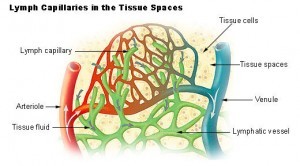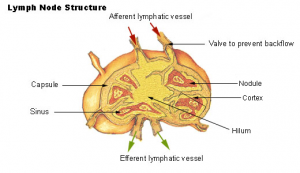Lymphatic System – Drainage, Functions, Organs
The lymphatic system is an additional channel for interstitial fluid from the tissue spaces to return to the bloodstream. Apart from the drainage of the excess tissue fluid, the lymphatic system also plays an important role in carrying larger particles, like proteins, which cannot enter the blood capillaries to return to the circulation.
Although the blood vessels, specifically the veins, carry away most of the fluid in the interstitial spaces, about 10% is transported via the lymphatic system. This equates to some 2 to 3 liters (65 to 100 fluid ounces) of lymphatic fluid draining into the venous circulation.
When the lymphatic system fails to function in an efficient manner, the excess fluid accumulates in the tissue spaces and causes swelling. Eventually it impairs the circulation in the area and compresses neighboring structures and organs causing a host of conditions. In addition, the proteins returned back into the circulation by the lymphatic system is crucial for sustaining life, and if this is impaired death may ensue, sometimes as soon as 24 hours.
Lympathic Organs
Lymphatic Vessels
Excess fluid from almost every organ enters into the lymphatic vessels which are channels designed for drainage. Certain organs, like the skin, muscles and bones, do not have these specialized vessels but rather have minute channels known as prelymphatics which then drain into lymphatic vessels. With the central nervous system, excess fluid that do not enter the lymphatic vessels instead drain into the cerebrospinal fluid (CSF) and then enter back into the blood.
Picture from Wikimedia Commons
Lymph Nodes
The lymphatic fluid (lymph) in the vessels then pass through one or more lymph nodes. Here the lymph is filtered and the nodes are an integral part of the body’s immune systems. Invading microorganisms that are carried out of the tissue spaces are identified, neutralized and the rest of the body’s immune system is recruited to act against the infection.
The lymph nodes also ensure that large populations of these pathogens do not return to the blood stream along with the lymphatic fluid thereby preventing the infection from spreading. Any pathogens that do enter the blood stream are later filtered partly by the liver but primarily by the spleen, which is seen as the largest lymph node in the human body.
Picture from Wikimedia Commons
Lymphatic Drainage
All lymphatic vessels empty its contents (lymph) into the blood stream, specifically the venous circulation. It does this primarily by emptying into two major conduits which drain into the veins – thoracic duct and right lymph duct.
Lymph from the upper body enter the venous circulation through two routes :
- Lymphatic vessels from the left side of the head, left arm and thoracic cavity empties lymph into the thoracic duct. This in turn drains into the blood stream at the junction of the left internal jugular and left subclavian vein.
- Lymphatic vessels from the right side of the head, right arm and right side of the thoracic cavity empties lymph into the right lymph duct. This in turn drains into the blood stream at the junction of the right subclavian vein and internal jugular vein.
Lymph from the lower part of the body travel via various lymphatic vessels to empty into the thoracic duct.
Functions of the Lymphatic System
- Drains excess fluid from the tissue spaces (interstitial fluid) and returns it into the blood stream.
- Carries fats absorbed from the gut (lacteals) into the blood stream where it reaches the liver and is processed.
- Returns large molecules like proteins back into the circulation.
- Filters tissue fluid, thereby removing invading microorganisms and mobilizing the immune system to protect the body.
- Controls the volume and pressure of the interstitial fluid which is important for gas, nutrient and waste exchange between the fluid in the cells (intracellular fluid) and that outside of the cells (extracellular fluid/interstitial fluid).







